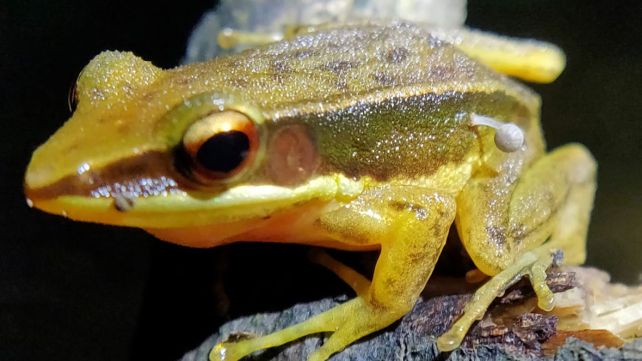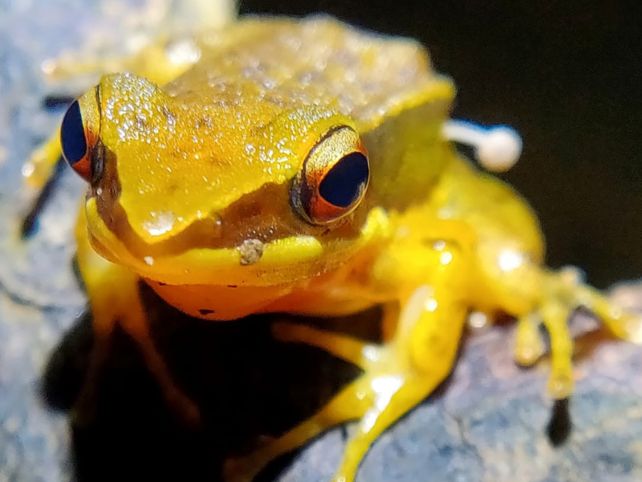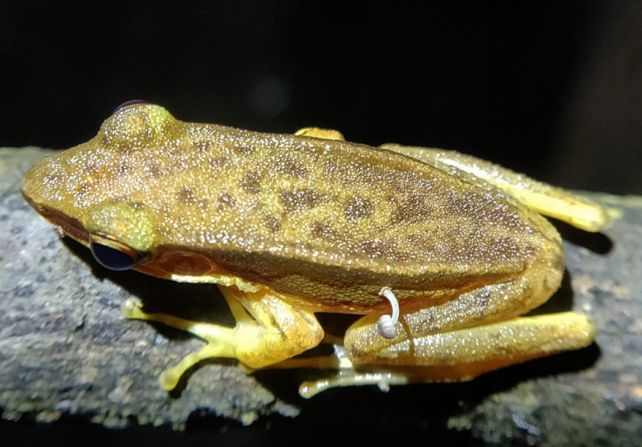ARTICLE AD
A frog has been spotted in the wilds of Karnataka in southwest India sporting a truly sassy accoutrement.
In what has to be the most goblin thing that ever goblined, scientists have recorded for the first time a living amphibian from whose skin had sprouted a mushroom.
The frog? A Rao's Intermediate Golden-backed Frog (Hylarana intermedia).
The mushroom? A Bonnet Mushroom (of the genus Mycena).
The pairing? Truly iconic.
In a relatively short paper published in the journal Reptiles & Amphibians, amateur naturalist Chinmay Maliye and wetlands specialist Lohit Y.T. of the World Wide Fund for Nature-India documented their encounter with the fashionable amphibian.
 "It's called fashion, look it up." (Maliye & Y.T., Reptil. amphib., 2024)
"It's called fashion, look it up." (Maliye & Y.T., Reptil. amphib., 2024)At first, the search for wild-life was a rather run-of-the-mill expedition. That was until they made a stop at a small, roadside pond, where 40 or so golden-backed frogs were frolicking. A closer look at one frog perched upon a twig revealed what appeared to be an extra appendage.
That in itself may not have been so odd. There's a parasite called a frog-mutating flatworm (Ribeiroia ondatrae) which induces frogs to grow extra hind legs. But this particular frog wasn't being parasitized by R. ondatrae.
Rather, its passenger was a cute little fungus that mycologists later identified as a species of Mycena.
 Milan, eat your heart out. (Maliye & Y.T., Reptil. amphib., 2024)
Milan, eat your heart out. (Maliye & Y.T., Reptil. amphib., 2024)Actually, finding frogs infected with fungus is not so strange either. A fungus called Batrachochytrium dendrobatidis – the amphibian chytrid fungus – is a fungus that causes in frogs a fatal infectious disease called chytridiomycosis. It has been found across the world, in more than 700 species of amphibian, and can devastate amphibian populations, resulting in local mass extinctions.
Bonnet mushrooms are not known to infect or grow on living animals. They are saprotrophic, and grow in leaf litter and on rotting wood, feeding themselves on the decay of organic matter, and playing a vital role in forest floor recycling.
 The frog and its accessory. (Maliye & Y.T., Reptil. amphib., 2024)
The frog and its accessory. (Maliye & Y.T., Reptil. amphib., 2024)Exactly how, and why, such a mushroom is able to thrive on the flank of a living frog – one that seemed otherwise quite normal and healthy – is unclear. The researchers didn't collect the specimen, so were unable to make a more detailed identification of the mushroom, or work out how it had sprouted on the frog.
Nor were they able to determine what effect, if any, this passenger had on the frog, and whether its growth was the result of, or causing any ill health effects, in the frog.
So if you happen to be foraging about in the damp woodlands, and come across a natty frog with a knack for accessorizing, do document the meeting, and let some scientists know. Enquiring minds have many questions.
The team's encounter was documented in Reptiles & Amphibians.

 11 months ago
84
11 months ago
84 

